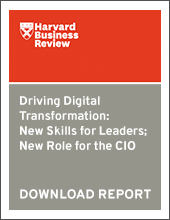When it comes to disruptive technologies, I strongly feel that we as IT leaders need to be the key advisor to all the different business lines in the company. Why? Quite simply because disruptive technology is disruptive to the business as well. We’re seeing that in a big way in retail over the last year and will continue to see it in 2015.
That’s why part of my role is to help our business leaders understand what disruptive technologies mean to them and how they will impact them in the future. This is much more a function of using these technologies to drive new businesses and new business models, not just leveraging them to improve efficiency or implement something differently.
Buy earbuds at retail? Why not print them?
Look at 3D printing as an example. Let’s say your customers are buying earbuds from you at retail. Along comes a new company that allows you to order a customized earbud online by downloading an app, taking a photo of your ear, and uploading it to them. Considering what’s on your shelf, it makes sense that a customer might say, “Hey, I’d much prefer the customized option over the standard earbuds that you have here.” That’s a disruptive idea.

But let’s say you use a disruptive technology like 3D printing to allow customers to order and print out an array of customized, personalized items right there in the store. That could be truly disruptive.
As trends like these emerge, thought leaders in IT are in a great position to advise on them. We don’t necessarily know all the answers either, so our efforts might be to offer recommendations on emerging technologies and to partner and prioritize with the business on others. We could discuss questions such as:
- Which technologies do we want to try to execute at a localized level in a pilot?
- How can we test whether we think “Technology X” will take off, and what investment it would take to do that?
- Which technologies have the biggest potential for return near term, and which are the “moonshots” that might bring us 10X return in a few years?
In retail, at least, whether you’re talking about disruptive or incremental innovation, you’ve got to understand several things:
- The customer’s context when they walk in the store: What are they thinking? What is it they need to accomplish that day and what are they trying to get done in the next set amount of time?
- How we can best suit the customer’s need at the exact moment that they’re in the store, or when they’re online, or even if they’re standing at gas station thinking of gifts they need to buy for relatives in the next week.
- How we can stay one step ahead of the customer at all times considering that there are barriers to adopting new technologies as quickly as the customers, and that things can turn on a dime.
These challenges can never stop you from pushing forward, of course. Although the cost of doing business is high in retail, you have to step up and deliver. The day you stop is the day your competitors start.
ALSO READ
Peter Buonora is a change agent driving alignment of business IT functions while evolving IT organizations from operational cost centers to a catalyst for competitive advantage. Peter’s extensive experience includes global technology strategy, architecture, cloud computing, and information security. Peter currently works as Enterprise Architect at BJ’s Wholesale Club, was formerly Senior Global Enterprise Architect at Ahold Corporation, and has held positions at Supervalu, John Hancock and other companies.




